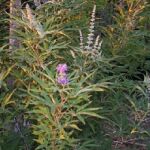| Common Name: |
Agnus Castus |
| Other Names: |
Chasteberry, Chaste Tree, Indian Spice, Monk's Pepper, Vitex |
| Botanical Name: |
Vitex agnus-castus |
| Genus: |
Vitex |
| Family: |
Verbenaceae |
| Native Location: |
Mediterranean to C Asia |
| Cultivation: |
Well-drained to poor dry soil in sun. Cut back the previous year's growth to 2.5-5cm (1-2in) in spring. Tolerates hard pruning. |
| Propagation: |
By seed sown when ripe or in spring; by semi-ripe cuttings in summer. |
| Harvest: |
Leaves are picked in early summer, and used fresh as juice, or in infusions and poultices, or dried for use in decoctions. Stems are cut in late summer or autumn and dried for use in decoctions and charcoal powder. Roots are lifted in late summer or autumn, and dried for use in decoctions. Fruits are collected in autumn, and used fresh or dried in decoctions or powder. Oil is extracted mainly from V. negundo var. cannabifolia. |
| Height: |
2-8m (6-25ft) |
| Width: |
2-8m (6-25ft) |
| Variations: |
latifolia
Is vigorous, with broader leaflets. |
| Hardiness: |
Z7-10 |
| History: |
For centuries chaste tree was strongly linked with chastity and celibacy. In ancient Greece, women taking part in sacred rituals dedicated to the goddess Demeter were required to refrain from sex—and they would string chaste tree leaves around their beds to dampen their sexual desire. During the Middle Ages, strewing chaste tree leaves over a young monk's vestments was believed to strengthen his vow of celibacy. As extra insurance against any romantic straying, the seeds of the tree were crushed and used as a spice in many monestaries—hence the popular common name Monk's pepper. These magical beliefs sprung, in part, from the fact that herbalists had long used chaste tree to treat the female reproductive system and in particular, to regulate the menstrual cycle. Modern researchers have confirmed that chaste tree contains progesterone like substances that make it an excellent remedy for irregular and heavy menstrual periods. The herb regulates menstrual cycles and decreases heavy bleeding by increasing the time between periods and shortening the length of the periods themselves. Chaste tree additionally relieves the mild depression, mood swings, and tension associated with both PMS and menopause. All these properties have made chaste tree one of the most popular, in-demand natural remedies for "women's complaints". |
| Parts Used: |
Fruits, Leaf |
| Properties: |
A pungent, bitter-sweet, slightly astringent, relaxant herb that regulates hormonal functions, promotes lactation, and relieves spasms and pain. |
| Medicinal Uses: |
Internally for menstral and menopausal complaints, infertility, insufficient lactation, and involuntary ejaculation. Combines well with Hydrastis canadensis for menopausal problems.
To treat impotence; to increase lactation, suppress appetite, and induce sleep. Germany's Commission E has approved the use of chaste tree berry to treat premenstrual syndrome, menstrual cycle irregularities, and breast pain.
Chaste tree has antispasmodic, astringent, calming, hormone-regulating, pain-relieving, and tonic properties. It also stimulates milk production in nursing mothers. Chaste tree is taken internally for acne, anxiety, bloating, cramps, depression, disturbed sleep, endometriosis, fibroid cysts, hormonal imbalances, irregular and/or heavy menstrual periods, menopausal symptoms, mood swings, premature ejaculation, premenstrual syndrome (PMS), and stress. |
| Preparation: |
Chaste tree is available as dried berries and in capsules, teas, and tinctures. To make a tea, pour 1 cup of boiling water over 1 teaspoon of dried berries and steep for 15 minutes. Drink 1/3 of a cup three times a day. |
| Typical Dose: |
A typical dose of chaste tree berry may range from 200 to 500 mg of dry powdered extract (4:1 dilution) taken three times daily. |
| Caution: |
Do not take chaste tree if you are pregnant or trying to conceive. Overconsumption of the herb may cause formication (the sensation of something crawling under the skin) and extreme itching. |
| Possible Side Effects: |
Chaste tree berry's side effects include rash, depression, diarrhea, and loss of appetite. |
| Drug Interactions: |
| Taking chaste tree berry with these drugs may increase the risk of dopaminergic side effects (such as nausea, vomiting, headache, and dizziness): |
| Amantadine, (Endantadine, Symmetrel) |
Bromocriptine, (Apo-Bromocriptine, Parlodel) |
Carbidopa, (Lodsoyn) |
Levodopa, (Dopar, Larodopa) |
| Levodopa-Carbidopa, (Nu-Levocarb, Sinemet) |
Pergolide, (Permax) |
Pramipexole, (Mirapex) |
Ropinirole, (Requip) |
| Taking chaste tree berry with these drugs may interfere with the action of the drug: |
| Ethinyl Estradiol and Desogestrel, (Cyclessa, Ortho-Cept) |
Ethinyl Estradiol and Drospirenone,(Yasmin) |
Ethinyl Estradiol and Ethynodiol Diacetate, (Demulen, Zovia) |
| Ethinyl Estradiol and Levonorgestrel, (Alessem Triphasil) |
Ethinyl Estradiol and Norethindrone, (Brevicon, Ortho-Novum) |
Ethinyl Estradiol and Norgestimate, (Cyclen, Ortho Tri-Cyclen) |
| Ethinyl Estradiol and Norgestrel, (Cryselle, Ovral) |
Mestranol and Norethindrone, (Necon 1/50, Ortho-Novum 1/50) |
Norgestrel, (Ovrette) |
|
| Lab Test Alterations: |
Decreased serum prolactin. |
| Disease Effects: |
- This herb may have hormonal effects ans should not be used by women with estrogen sensitive breast cancer or other hormone-sensitive conditions.
- May interfere with in vitro fertilization.
|
| Culinary Uses: |
Fruits are used as a substitute for pepper, and in the Middle Eastern spice mixes. |
| Warning: |
Excess causes nerve disorder known as formication (sensation of insects crawling under the skin). |
| Bibliography: |
The Encyclopedia of Herbs by Deni Bown Copyright © 1995, 2005. Dorling Kindersley Limited. pg 406.
The Essential Herb-Drug-Vitamin Interaction Guide by Geo. T. Grosberg,MD and Barry Fox,PhD. Copyright ©2007 Barry Fox,PhD. Pp.144-145
The Modern Herbal Primer by Nancy Burke Copyright©2000 Yankee Publishing, Inc. pg 135 |
